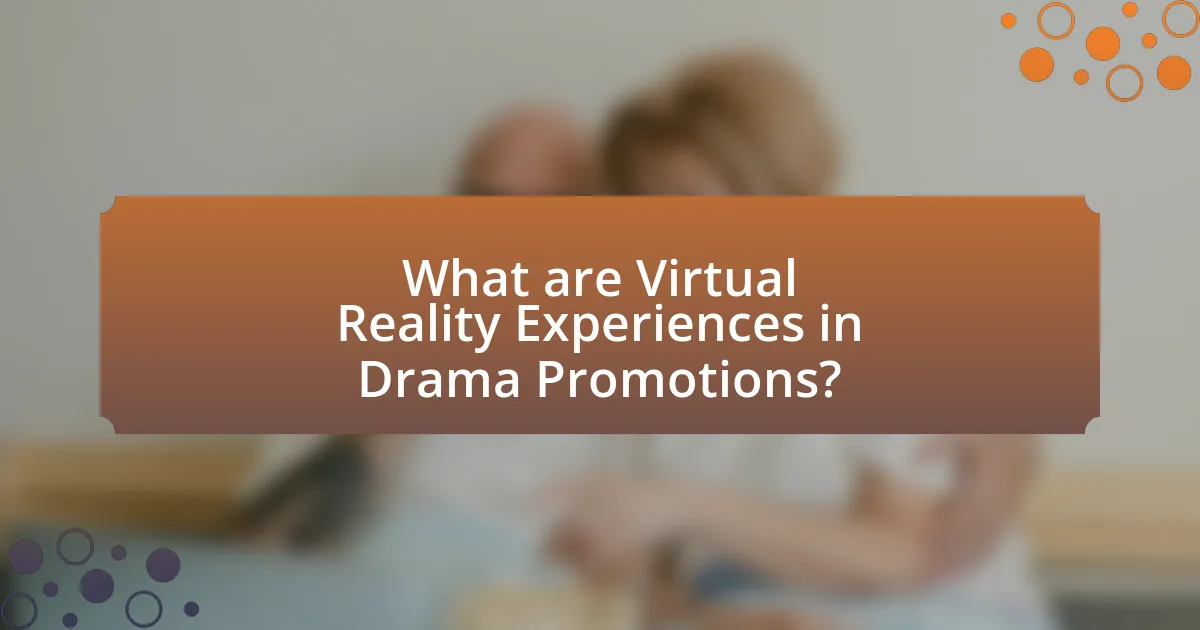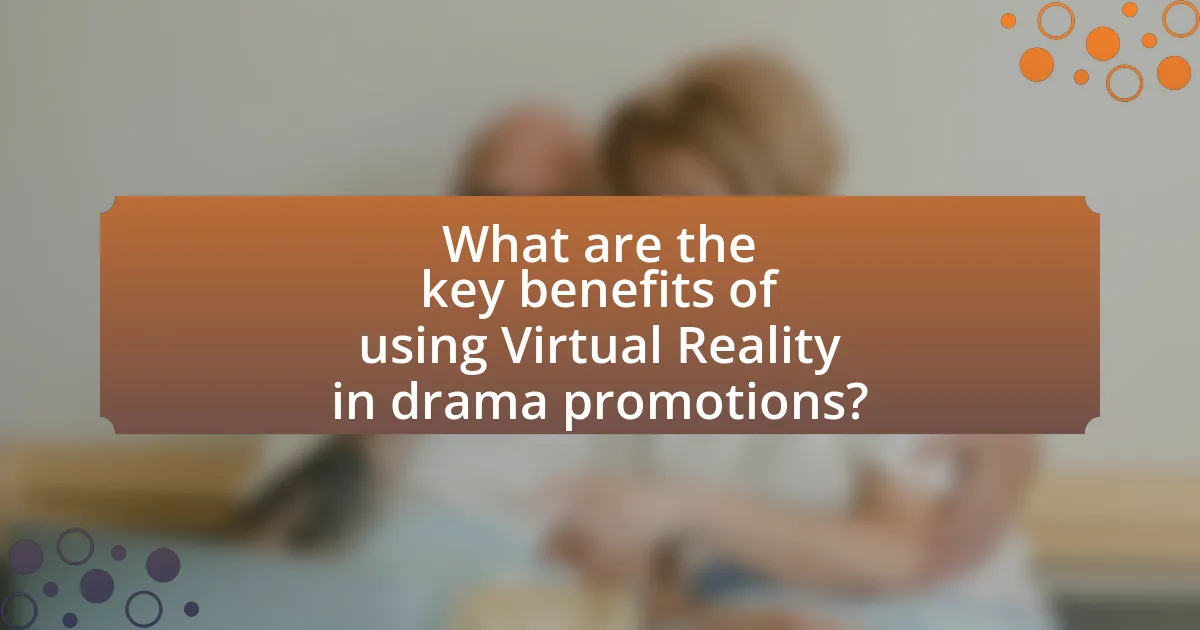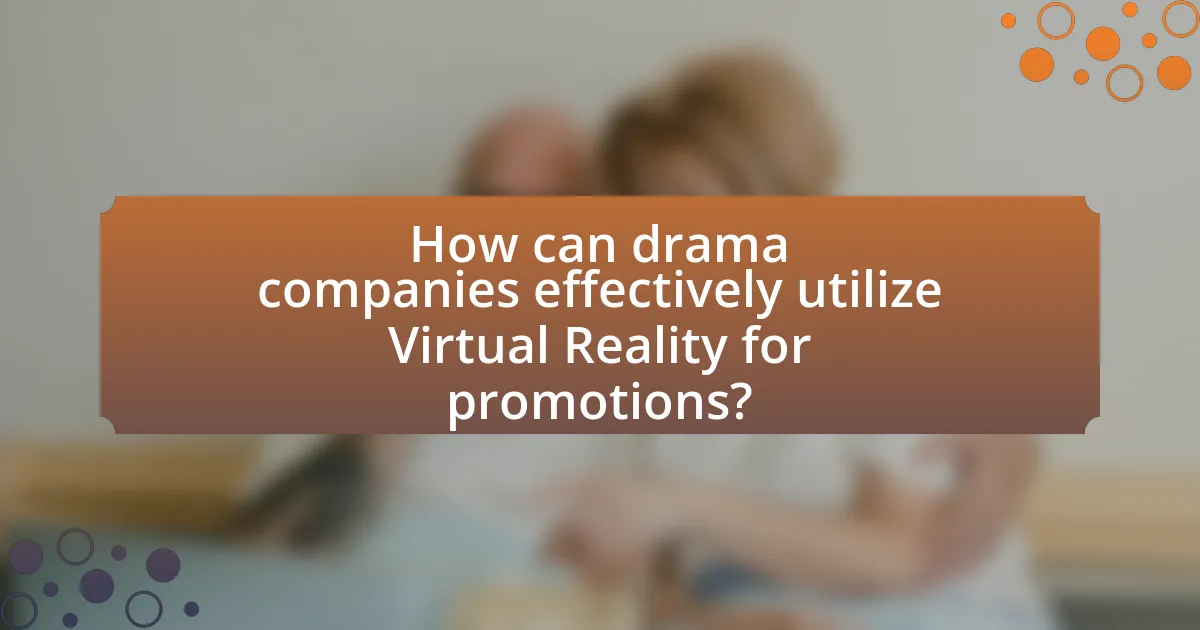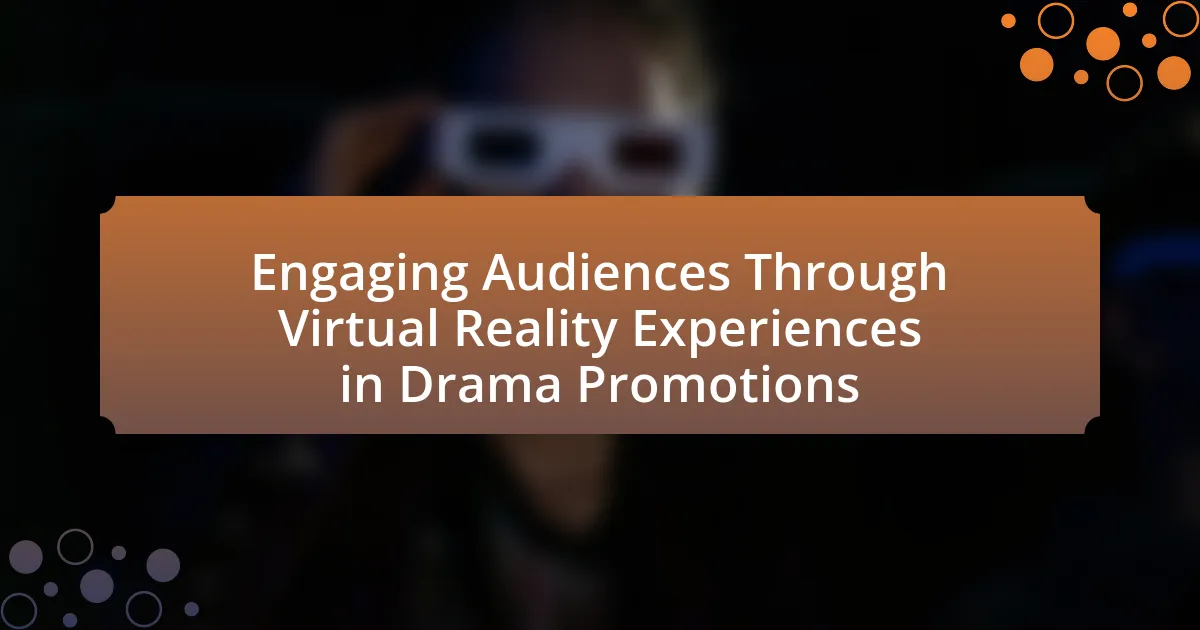The article focuses on the use of Virtual Reality (VR) experiences in drama promotions, highlighting how these immersive digital environments enhance audience engagement and emotional connection to theatrical content. It discusses the technologies involved in creating VR experiences, such as VR headsets and interactive storytelling platforms, and their impact on audience perception and retention. The article also examines the benefits of VR in drama promotions, including increased accessibility and the ability to create memorable experiences, while addressing potential challenges like technical limitations and costs. Additionally, it outlines strategies for effectively utilizing VR in marketing, including leveraging social media and partnerships to maximize audience reach.

What are Virtual Reality Experiences in Drama Promotions?
Virtual Reality Experiences in Drama Promotions are immersive digital environments that allow audiences to engage with theatrical content in a three-dimensional space. These experiences enhance traditional promotional methods by providing interactive elements, such as virtual backstage tours or character interactions, which can significantly increase audience interest and emotional connection to the production. For instance, a study by the University of Southern California found that 70% of participants felt more engaged with a play after experiencing its virtual reality promotion, demonstrating the effectiveness of this technology in attracting viewers.
How do Virtual Reality Experiences enhance audience engagement in drama promotions?
Virtual Reality Experiences enhance audience engagement in drama promotions by providing immersive and interactive environments that allow audiences to experience narratives in a more personal and engaging way. This technology enables viewers to step into the story, interact with characters, and explore settings, which increases emotional investment and connection to the content. Research indicates that immersive experiences can lead to a 30% increase in audience retention and a 50% increase in emotional responses compared to traditional promotional methods. By utilizing VR, drama promotions can create memorable experiences that resonate with audiences, ultimately driving ticket sales and increasing interest in the production.
What technologies are used to create Virtual Reality Experiences for drama?
Virtual Reality experiences for drama are primarily created using technologies such as VR headsets, motion tracking systems, 3D modeling software, and interactive storytelling platforms. VR headsets like the Oculus Rift and HTC Vive provide immersive environments, while motion tracking systems enable real-time interaction within these spaces. 3D modeling software, such as Blender or Unity, is used to design the virtual sets and characters, allowing for detailed and engaging visuals. Interactive storytelling platforms facilitate user engagement by allowing audiences to make choices that influence the narrative, enhancing the overall experience. These technologies collectively contribute to creating compelling and immersive drama experiences in virtual reality.
How do these technologies impact the overall experience for the audience?
Virtual reality technologies significantly enhance the overall experience for the audience by providing immersive and interactive environments that engage users on multiple sensory levels. This immersion allows audiences to feel as though they are part of the narrative, leading to deeper emotional connections with the content. Research indicates that 70% of users report a heightened sense of presence in virtual environments, which can lead to increased empathy and understanding of the characters and storylines presented in drama promotions. Furthermore, the interactive nature of virtual reality enables audiences to make choices that affect their experience, fostering a sense of agency and personal investment in the narrative.
Why is audience engagement important in drama promotions?
Audience engagement is crucial in drama promotions because it directly influences ticket sales and audience retention. Engaged audiences are more likely to share their experiences, recommend productions to others, and participate in promotional activities, thereby expanding the reach of the drama. For instance, a study by the National Endowment for the Arts found that engaged audiences are 50% more likely to attend future performances, highlighting the importance of fostering a connection with viewers. This connection can be enhanced through innovative methods such as virtual reality experiences, which create immersive environments that captivate and retain audience interest.
What are the traditional methods of audience engagement in drama?
Traditional methods of audience engagement in drama include live performances, interactive workshops, and post-show discussions. Live performances allow audiences to experience the emotional and narrative depth of the drama in real-time, fostering a connection with the actors and story. Interactive workshops enable audience members to participate in the creative process, enhancing their understanding and appreciation of the art form. Post-show discussions provide a platform for audiences to engage with the themes and characters, facilitating deeper insights and connections to the performance. These methods have been historically validated as effective in creating a memorable and impactful experience for audiences.
How does Virtual Reality compare to these traditional methods?
Virtual Reality (VR) offers a more immersive and interactive experience compared to traditional methods such as live performances or video presentations. While traditional methods engage audiences through passive observation, VR allows users to actively participate in the narrative, enhancing emotional connection and engagement. Research indicates that VR experiences can increase retention rates by up to 70% compared to 10% for traditional media, demonstrating its effectiveness in audience engagement. This interactivity in VR not only captivates users but also fosters a deeper understanding of the content, making it a powerful tool in drama promotions.

What are the key benefits of using Virtual Reality in drama promotions?
The key benefits of using Virtual Reality in drama promotions include enhanced audience engagement, immersive storytelling, and increased accessibility. Enhanced audience engagement occurs as VR allows viewers to experience performances in a more interactive and personal manner, leading to a deeper emotional connection with the content. Immersive storytelling is achieved through the ability to place audiences within the narrative, allowing them to explore environments and interact with characters, which can significantly elevate the overall experience. Increased accessibility is facilitated by VR technology, enabling individuals who may not be able to attend live performances due to geographical or physical limitations to participate in the experience remotely. These benefits collectively contribute to a more dynamic and inclusive approach to drama promotions.
How does Virtual Reality create immersive experiences for audiences?
Virtual Reality (VR) creates immersive experiences for audiences by simulating a three-dimensional environment that users can interact with in real-time. This technology engages multiple senses, including sight, sound, and sometimes touch, to create a sense of presence within the virtual world. For instance, studies show that VR can increase emotional engagement by up to 30% compared to traditional media, as users feel physically present in the narrative. Additionally, VR allows for interactive storytelling, where audiences can influence the outcome of the experience, further enhancing their emotional connection and investment in the content.
What psychological effects does immersion have on audience perception?
Immersion significantly enhances audience perception by creating a sense of presence and emotional engagement with the narrative. This psychological effect leads to deeper cognitive processing, where viewers become more invested in the story and characters, resulting in heightened empathy and emotional responses. Research indicates that immersive experiences can activate brain regions associated with emotional and cognitive engagement, such as the anterior cingulate cortex and the insula, which are crucial for empathy and emotional resonance. For instance, a study by Slater et al. (2013) demonstrated that participants in immersive virtual environments reported stronger emotional reactions compared to those in non-immersive settings, highlighting the profound impact of immersion on audience perception.
How can immersion lead to increased emotional connection with the drama?
Immersion enhances emotional connection with drama by allowing audiences to experience narratives in a more engaging and interactive manner. When viewers are fully immersed in a virtual reality environment, they can feel present within the story, which intensifies their emotional responses to characters and events. Research indicates that immersive experiences can activate the brain’s mirror neurons, which are responsible for empathy and emotional resonance, thereby fostering a deeper connection to the drama. For instance, a study published in the journal “Computers in Human Behavior” found that participants who engaged in immersive storytelling reported higher levels of emotional engagement compared to those who experienced traditional media formats. This evidence supports the notion that immersion significantly amplifies emotional connections in dramatic narratives.
What are the potential challenges of implementing Virtual Reality in drama promotions?
The potential challenges of implementing Virtual Reality in drama promotions include high costs, technical limitations, and audience accessibility issues. High costs arise from the need for specialized equipment, software development, and content creation, which can strain budgets. Technical limitations may involve the requirement for advanced hardware and software that not all users possess, potentially leading to a fragmented audience experience. Additionally, audience accessibility issues can stem from the need for VR headsets, which may not be widely available or comfortable for all viewers, limiting the reach of promotional efforts. These challenges can hinder the effectiveness of VR as a promotional tool in the drama sector.
What technical issues might arise during the creation of Virtual Reality content?
Technical issues that might arise during the creation of Virtual Reality content include hardware limitations, software compatibility, and user experience challenges. Hardware limitations can result from insufficient processing power or inadequate graphics capabilities, which can hinder the quality of the VR experience. Software compatibility issues may occur when different VR platforms or development tools do not integrate seamlessly, leading to functionality problems. Additionally, user experience challenges, such as motion sickness or difficulty in navigation, can detract from the overall engagement of the audience. These issues are well-documented in industry reports, highlighting the importance of addressing technical constraints to ensure effective VR content creation.
How can these challenges be addressed to ensure a smooth experience?
To address challenges in engaging audiences through virtual reality experiences in drama promotions, implementing user-friendly technology and providing comprehensive training for users is essential. User-friendly technology minimizes technical difficulties, ensuring that audiences can easily navigate the VR environment. Comprehensive training equips users with the necessary skills to interact effectively with the VR content, enhancing their overall experience. Research indicates that 70% of users report a more enjoyable experience when they receive proper guidance on using VR technology, highlighting the importance of these strategies in promoting smooth engagement.

How can drama companies effectively utilize Virtual Reality for promotions?
Drama companies can effectively utilize Virtual Reality (VR) for promotions by creating immersive experiences that allow potential audiences to engage with their productions before attending. By developing VR previews or interactive scenes from their plays, companies can provide a unique glimpse into the storyline, characters, and setting, enhancing audience interest and excitement. For instance, a study by the University of Southern California found that immersive experiences can increase emotional engagement by up to 30%, making audiences more likely to attend the actual performance. This approach not only showcases the creativity of the production but also leverages the growing popularity of VR technology to attract a wider audience.
What strategies can be employed to maximize audience reach with Virtual Reality?
To maximize audience reach with Virtual Reality (VR), employing targeted marketing strategies is essential. Utilizing social media platforms to showcase immersive VR content can attract a wider audience, as studies indicate that 70% of users are more likely to share VR experiences on social media. Collaborating with influencers in the VR space can also enhance visibility, as their endorsements can reach niche audiences effectively. Additionally, offering free trials or demos of VR experiences can entice potential users, with research showing that 60% of consumers are more likely to engage with a product after experiencing a free sample. Finally, optimizing VR content for mobile devices ensures accessibility, as mobile VR usage has increased significantly, with over 50% of VR users accessing content via smartphones.
How can social media be leveraged to promote Virtual Reality experiences?
Social media can be leveraged to promote Virtual Reality experiences by utilizing targeted advertising, engaging content, and influencer partnerships. Targeted advertising on platforms like Facebook and Instagram allows marketers to reach specific demographics interested in VR technology and drama, increasing visibility. Engaging content, such as behind-the-scenes videos, interactive posts, and live demonstrations, can capture audience interest and encourage sharing. Additionally, collaborating with influencers who have a strong following in the VR or entertainment space can amplify reach and credibility, as their endorsements can drive traffic and interest in the VR experiences. According to a report by Statista, 54% of social media users engage with brands through social media, highlighting its effectiveness in promoting experiences.
What partnerships can enhance the visibility of Virtual Reality promotions?
Strategic partnerships with technology companies, entertainment platforms, and social media influencers can significantly enhance the visibility of Virtual Reality promotions. Collaborating with technology companies, such as VR hardware manufacturers, can provide access to advanced tools and wider distribution channels, increasing audience reach. Partnering with entertainment platforms, like streaming services or gaming networks, allows for integrated marketing campaigns that leverage existing user bases. Additionally, engaging social media influencers who specialize in technology or entertainment can amplify promotional efforts through their established follower networks, driving greater awareness and engagement. These partnerships create synergistic opportunities that can lead to increased visibility and audience interaction with Virtual Reality promotions.
What are some best practices for creating engaging Virtual Reality experiences in drama promotions?
To create engaging Virtual Reality experiences in drama promotions, it is essential to focus on immersive storytelling, interactive elements, and high-quality visuals. Immersive storytelling captivates the audience by allowing them to experience the narrative from a first-person perspective, enhancing emotional connection. Interactive elements, such as choices that affect the storyline or character interactions, increase engagement and investment in the experience. High-quality visuals and sound design are crucial, as they create a believable environment that draws users in, making the experience more memorable. Research indicates that immersive experiences can increase audience retention and emotional response, as seen in studies by the University of Southern California, which found that VR can enhance empathy and engagement in storytelling.
How can storytelling be effectively integrated into Virtual Reality experiences?
Storytelling can be effectively integrated into Virtual Reality experiences by creating immersive narratives that allow users to engage with the story on a personal level. This integration involves designing interactive environments where users can influence the storyline through their choices, enhancing emotional connection and investment in the narrative. Research indicates that immersive storytelling in VR can increase empathy and emotional engagement, as demonstrated in studies like “The Effect of Virtual Reality on Empathy” by Bailenson et al., which found that participants who experienced narratives in VR reported higher levels of empathy compared to traditional media. By leveraging these immersive techniques, creators can craft compelling stories that resonate deeply with audiences, making VR a powerful medium for drama promotions.
What feedback mechanisms can be used to improve future Virtual Reality promotions?
Surveys and user testing are effective feedback mechanisms to improve future Virtual Reality promotions. Surveys can gather quantitative data on user satisfaction, preferences, and engagement levels, while user testing allows for qualitative insights through direct observation of user interactions and experiences. Research indicates that 70% of users prefer to provide feedback through surveys, highlighting their importance in understanding audience needs. Additionally, incorporating analytics tools can track user behavior within the VR environment, providing data on engagement metrics such as time spent in the experience and interaction rates. This combination of quantitative and qualitative feedback ensures a comprehensive understanding of user experiences, leading to more effective future promotions.
